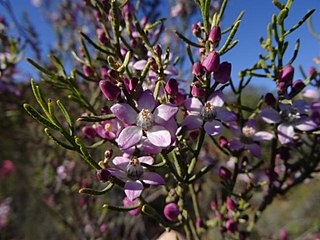
Philotheca salsolifolia is a species of flowering plant in the family Rutaceae and is endemic to New South Wales and the Australian Capital Territory. It is a shrub with crowded, more or less cylindrical leaves and pink to mauve flowers with a dark central stripe and arranged singly or in twos or threes on the ends of branchlets.

Philotheca reichenbachii is a species of flowering plant in the family Rutaceae and is endemic to New South Wales. It is a shrub with upright branchlets, crowded, linear or cylindrical leaves and pink to purple flowers arranged singly or in twos or threes on the ends of branchlets.

Philotheca brucei is a species of flowering plant in the family Rutaceae and is endemic to Western Australia. It is a shrub with cylindrical leaves grooved along the top and in spring, white to pink or mauve flowers with five egg-shaped petals.
Philotheca apiculata is a species of flowering plant in the family Rutaceae and is endemic to the south-west of Western Australia. It is a small shrub with narrow club-shaped leaves and small clusters of white to pink flowers on the ends of branchlets.
Philotheca citrina is a species of flowering plant in the family Rutaceae and is endemic to Western Australia. It is a much-branched shrub with curved, narrow club-shaped leaves and pale yellowish green flowers arranged singly on the ends of branchlets.
Philotheca coateana is a species of flowering plant in the family Rutaceae and is endemic to Western Australia. It is a small shrub with small, elliptical leaves and white flowers with a pink midline, arranged singly on the ends of branchlets.

Philotheca coccinea is a species of flowering plant in the family Rutaceae and is endemic to Western Australia. It is a shrub with club-shaped leaves that are warty on the lower surface, and red to pink flowers arranged singly in leaf axils.
Philotheca eremicola is a species of flowering plant in the family Rutaceae and is endemic to Western Australia. It is a small shrub similar to Philotheca coateana but has smaller leaves and different sepals.
Philotheca fitzgeraldii is a species of flowering plant in the family Rutaceae and is endemic to the south of Western Australia. It is an erect, compact or spreading shrub with cylindrical, glandular-warty leaves and white flowers arranged singly in leaf axils and on the ends of branchlets.

Philotheca gardneri is a species of flowering plant in the family Rutaceae and is endemic to the south-west of Western Australia. It is a shrub with crowded, narrow club-shaped or more or less spherical leaves and white flowers with a prominent pink midrib, usually borne singly on the ends of branchlets.
Philotheca glabra is a species of flowering plant in the family Rutaceae and is endemic to the inland south-west of Western Australia. It is a small shrub with elliptical to club-shaped leaves and white flowers tinged with pink and arranged singly or in twos or three on the ends of branchlets.
Philotheca langei is a species of flowering plant in the family Rutaceae and is endemic to a restricted area of the south-west of Western Australia. It is a small shrub with club-shaped, glandular-warty leaves and white flowers arranged singly or in twos or threes on the ends of branchlets.

Philotheca linearis, commonly known as the rock wallaby shrub or narrow-leaf wax-flower, is a species of flowering plant in the family Rutaceae and is endemic to an inland areas of southern Australia. It is a shrub with glandular-warty branchlets and leaves, club-shaped to cylindrical leaves and white flowers arranged singly in leaf axils.
Philotheca nutans is a species of flowering plant in the family Rutaceae and is endemic to the south-west of Western Australia. It is a small, densely-branched shrub with club-shaped to cylindrical, glandular-warty leaves and pendent, pale yellow to pale red flowers arranged singly in leaf axils.

Philotheca pinoides is a species of flowering plant in the family Rutaceae and is endemic to the south-west of Western Australia. It is a small, erect undershrub with needle-shaped, glandular-warty leaves and pale pink or red flowers arranged singly or in groups of up to three in the axil of leaves at the end of branchlets.

Philotheca rhomboidea is a species of flowering plant in the family Rutaceae and is endemic to the south-west of Western Australia. It is a small undershrub with thick, broadly elliptic to round leaves and white to pale pink flowers arranged singly or in twos or threes at the end of branchlets.

Philotheca sericea is a species of flowering plant in the family Rutaceae and is endemic to the south-west of Western Australia. It is an undershrub with small oval to elliptical leaves and white to pink flowers usually arranged singly at the end of branchlets.

Philotheca tomentella is a species of flowering plant in the family Rutaceae and is endemic to the south-west of Western Australia. It is an undershrub with small club-shaped to cylindrical leaves and white flowers with a pale red central stripe, arranged singly or in groups of up to four on the ends of branchlets.

Philotheca virgata, commonly known as Tasmanian wax-flower, is a species of flowering plant in the family Rutaceae and is endemic to south-eastern Australia. It is a slender, erect shrub with wedge-shaped to oblong leaves and white or pale pink flowers at the ends of branchlets. It is the only philotheca with four sepals and petals.
Philotheca wonganensis, commonly known as Wongan philotheca, is a species of flowering plant in the family Rutaceae and is endemic to the south-west of Western Australia. It is a shrub with thin, cylindrical leaves and white flowers with a pink central stripe, usually arranged singly in leaf axils.











